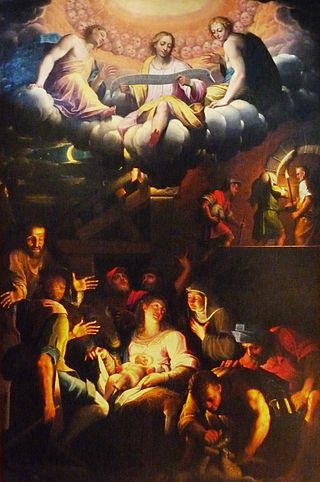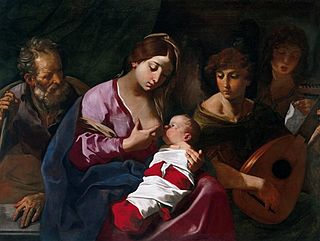Related Research Articles

1570 (MDLXX) was a common year starting on Sunday in the Julian calendar.

The Abravanel family, also spelled as Abarbanel, Abrabanel, Avravanel, Barbernell, or Barbanel – literally meaning Ab ("father") rabban ("priest") el – is one of the oldest and most distinguished Jewish families. It first achieved prominence on the Iberian Peninsula during the Middle Ages. Its members claim to trace their origin to the biblical King David. Members of this family lived in Seville, Córdoba, Castile-Leon, and Calatayud. Seville is where its most prominent representative, Don Judah Abravanel, once dwelt.

Girolamo Da Carpi was an Italian painter and decorator who worked at the Court of the House of Este in Ferrara. He began painting in Ferrara, by report apprenticing to Benvenuto Tisi ; but by age 20, he had moved to Bologna, and is considered a figure of Early Renaissance painting of the local Bolognese School.

Benvenuto Tisi, also known as Il Garofalo, was a Late-Renaissance-Mannerist Italian painter of the School of Ferrara. Garofalo's career began attached to the court of the Duke d'Este. His early works have been described as "idyllic", but they often conform to the elaborate conceits favored by the artistically refined Ferrarese court. His nickname, Garofalo, may derive from his habit of signing some works with a picture of a carnation.

Alfonso d'Este was Duke of Ferrara during the time of the War of the League of Cambrai.
The year 1500 in art involved some significant events and new works.
Carlo Bononi was an Italian painter. An 1876 book lists him among "the last artists of any eminence in Ferrara".
The School of Ferrara was a group of painters which flourished in the Duchy of Ferrara during the Renaissance. Ferrara was ruled by the Este family, well known for its patronage of the arts. Patronage was extended with the ascent of Ercole d'Este I in 1470, and the family continued in power till Alfonso II, Ercole's great-grandson, died without an heir in 1597. The duchy was then occupied in succession by Papal and Austrian forces. The school evolved styles of painting that appeared to blend influences from Mantua, Venice, Lombardy, Bologna, and Florence.
Events from year 1632 in art.

Barbara of Austria, was an Archduchess of Austria as a member of the House of Habsburg and by marriage Duchess consort of Ferrara, Modena and Reggio during 1565–1572.
Jacopo Bambini was an Italian painter of the Baroque period, active mainly in Ferrara.
Alfonso Rivarola was an Italian painter of the Baroque period, active mainly in Ferrara, where he was born. He is also known as il Chenda because of an inheritance he received from someone with that name.

Giovanni Battista Trotti was an Italian painter of the late-Renaissance period, active mainly in Piacenza, Parma, and his native city of Cremona.

Flaminio Torri) was an Italian Baroque painter of the Bolognese School, active during the Baroque period.

Vincenzo Spisanelli (1595–1662) was an Italian painter of the Baroque period, active mainly in Bologna. He is also called Lo Spisanelli or Pisanelli, Spisano, or Spisani.
Antonio Bonfanti was an Italian painter. He was also called Il Torricella. He was a native of Ferrara, where he painted a Presentation of Mary at Temple and Dispute among Doctors for the chancel of the church of San Francesco and a Holy Family for the church of La Santissima Trinità. He was a pupil or follower of Guercino. His brother Giulio was also a painter.

Francesco Bianchi was an Italian painter of the Renaissance period. He is also known as Francesco del Bianchi Ferrara and Il Frare. He was born at Ferrara. Modena is also mentioned as the place of his birth. His works were much esteemed in his time. He was a pupil of Cosimo Tura. He is said to have been an instructor of Correggio, but Bianchi would have died when the former was only 16 years old.

Josef Theodor Moroder, also known as the Lusenberger, was a painter and sculptor, the most prominent artist of the Moroder family from the Grödenthal in South Tyrol.
Antonio Cimatori, called Il Visacci was an Italian painter.

Domenico Mona (1550–1602) was an Italian painter of the late-Renaissance period, born in Ferrara.
References
- 1 2 Fiorillo, Johann Dominik (1801). Geschichte Der Zeichnenden Künste Von Ihrer Wiederauflebung Bis Auf Die Neuesten Zeiten: Geschichte der venezianischen, lombardischen und der übrigen italienischen Schulen (in German). J. G. Rosenbusch. Page 621
- ↑ A hand-book for travellers in central Italy: including the Papal states., John Murray (firm), page 631.
- ↑ Hare, Augustus John Cuthbert (1876). In Venetia, Parma, the Emilia, the Marche, and morthern Tuscany. G. Routledge & sons. Page 175
Attribution:
 This article incorporates text from a publication now in the public domain : Bryan, Michael (1886). "Cromer, Giulio". In Graves, Robert Edmund (ed.). Bryan's Dictionary of Painters and Engravers (A–K). Vol. I (3rd ed.). London: George Bell & Sons.
This article incorporates text from a publication now in the public domain : Bryan, Michael (1886). "Cromer, Giulio". In Graves, Robert Edmund (ed.). Bryan's Dictionary of Painters and Engravers (A–K). Vol. I (3rd ed.). London: George Bell & Sons.